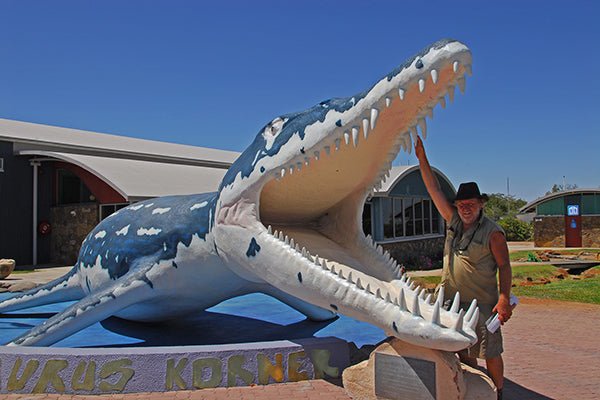
Secrets of Our Ancient Fossilised Sea
|
|
Time to read 2 min
|
|
Time to read 2 min
Right now, Australia is a hotbed for prehistoric research, particularly in central and northern Queensland, with almost all of it accessible to those towing a camper trailer.
Teams are still finding fossilised specimens in sandstones and shale deposits formed in a former vast inland sea, extending from the Gulf of Carpentaria to central Queensland, northern NSW and South Australia.
Before the archaeological boom, finds were often made by property owners but, in the past 20 years, concerted efforts are uncovering evidence of a whole new world of creatures dating to the age of dinosaurs in far-reaching outcrops and on featureless plains.
Many varieties of species have been found in the waters, shores and on islands of this inland sea, including huge sauropod dinosaurs, with their long necks and tails making them among the largest ever to have walked the earth. Meat-eating theropods have also been uncovered, some similar to the famous T-Rex, others similar in size to a chicken, winged pterosaurs and huge marine reptiles. Travellers can now enjoy these finds and even partake in diggings or the preparation of the fossils.
Richmond was home to the Kronosaurus Korner and has a statue and a museum displaying local finds. Kronosaurus was a large marine predator, growing to 11m in length, with a head more than 2m in length full of huge teeth. Its best known specimen ‘Kris’ was dug up by an American expedition in 1932 and restored in 1959, when a family donated funds to Harvard University.
In Lark Quarry, 110km south-west of Winton, you'll find evidence of a 3300 footprint stampede, caused by small panic-stricken dinosaurs attempting to escape a large two-legged carnivore. The footprints, left in mud around the edge of a lake, are housed and preserved for all to see.
In Winton, the Heritage-Listed Corfield and Fitzmaurice general store holds a collection of dinosaur and other fossil remains.
The Australian Age of Dinosaurs Museum in Central Queensland is a real gem, found 13km south of Winton and 12km off the Landsborough Highway on a gravel road. The museum runs tours of its fossil preparation area and exhibits. If you are super-keen, you can join the museum staff in preparing specimens for display, or join a field expedition to dig for dinosaur remains.
West to Boulia is another collection of dinosaur-aged marine fossils from an area well away from any remains of land living organisms. Here, (and the Kronosaurus Corner), you’ll learn of the recent rare discovery of an early dino-bird evolving from dinosaur ancestors.
AUSTRALIAN AGE OF DINOSAURS
Just about anyone can dig for fossils thanks to efforts of grazier David Elliott. David discovered a fossilised bone in 1999 mustering on his property, Belmont, near Winton, which was later identified as a partial femur from a huge sauropod.
Inspired, David and his wife worked with the Winton community to ensure similar finds were safely preserved and as a result the Australian Age of Dinosaurs not-for-profit-organisation was formed, with the Australian Age of Dinosaurs Museum opening in 2009 on donated land.
Volunteers and patrons of the museum threw the door wide open on local dinosaur excavations in Australia, producing a flood of specimens from the area around Winton. The whole view on the Cretaceous period’s fauna has changed drastically, all due to the enthusiasm and determination of one grazier and his wife.
OUR INLAND SEA
Australia’s fossilised inland sea formed during global floods 145 million years ago (Ma). At the time, Australia was attached to Antarctica, as a part of the global supercontinent Gondwana. But narrow seaways on our southern and western margins were forming the rift that would cause us to shift north-east.
Despite our location, the climate was much warmer, with tropical conditions as far south as latitude 70° (lower than Tasmania today) and the mean average temperature 10-15°C warmer than today. Sedimentary deposits formed, trapping the animal remains living in and around the waters. Those sediments hold the waters of our Great Artesian Basin.